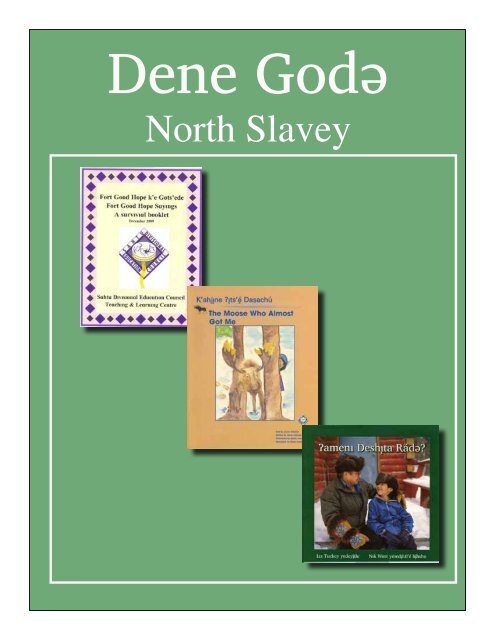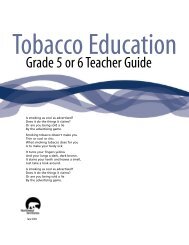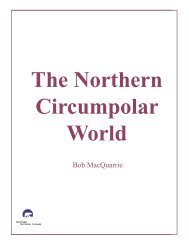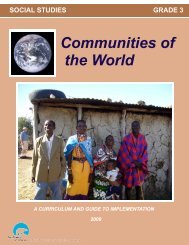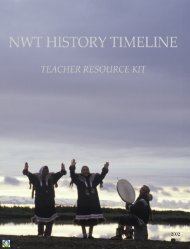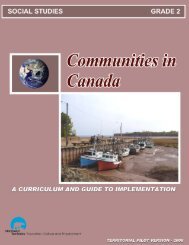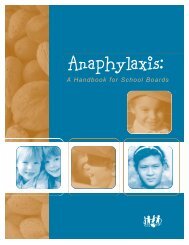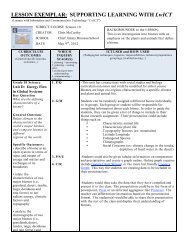North Slavey Bibliography - South Slave Divisional Education Council
North Slavey Bibliography - South Slave Divisional Education Council
North Slavey Bibliography - South Slave Divisional Education Council
- No tags were found...
You also want an ePaper? Increase the reach of your titles
YUMPU automatically turns print PDFs into web optimized ePapers that Google loves.
Dene Godœ<strong>North</strong> <strong><strong>Slave</strong>y</strong>
Dene Godœ - <strong>North</strong> <strong><strong>Slave</strong>y</strong>Æameni Deshîta Rádœ? - Who Lives in the Bush?Liz Tuckey , Teaching and Learning Centre-Tulita, (2007). 24 pages;elementaryEAEA young Dene boy and his grandfather travel down a path talkingabout all the animal that live in the bush. This beautiful photographsof animals behind the boy and his grandfather will delight allreaders.Themes: All animals, Family, Grandparents, EldersL1Tewe Yatî Æagõht’e? - Is It Christmas Yet?Eileen Beaver, Teaching and Learning Centre-Tulita, (2007). 24pages; elementaryEAEA young boy, eagerly awaiting Christmas, is reminded of theholiday season everywhere he looks but his excitement gets the bestof him in a surprise ending. This book features repetitive andpredictable text.Themes: Family, Celebrations, SeasonsL1Seni W’ela - Me TooBrent Kaulback & Eileen Beaver, Teaching and Learning Centre-Tulita, (2007). 32 pages, elementaryA young Dene boy tries to be like his grandfather as he mimics themany jobs and tasks his grandfather does. Conversations aboutfamily roles and traditional ways of learning can ensue from thisstory.Themes: Family, Grandparents, Child, PlayEAL1EK’ñtu - Birch WaterBrent Kaulback , Teaching and Learning Centre-Tulita (2007). 32pages; elementary and high school-upBirch Water describes in pictures and easy-to-read text the processused by a students at Chief Sunrise <strong>Education</strong> Centre to turn birchwater, the water that comes from tapping a birch tree, into the darksweet syrup known as Ki TúEAL2EThemes: Trees, Earth Medicine, Plants, Eating and Food
Dene Godœ Tåîchô Yatie - - <strong>North</strong> <strong>South</strong> Dogrib<strong><strong>Slave</strong>y</strong>Œhts£œ Yahts’ule Alé Bedak£reht’ñ - First Vision of GrandpaMackenzie Andrew Leon Andrew, Teaching and LearningCentre-Tulita, (2004). 16 pages; elementary - high school-upThis childhood memory describes an incident that occurred whenMackenzie Andrew, a Tulita elder, was troubled by the actions of anRCMP officer. The story tells the importance of dreams and visions.Themes: Spirituality, non-DeneAEL2K’ahjîne Æîts’ç Dasachú - The Moose Who Almost Got MeJonas Neyelle, Teaching and Learning Centre-Tulita, (2004). 20pages; elementary - high school-upThe challenges faced while hunting are described in this humorousstory. Two brothers come face to face with a moose running towardsthem and neither have their rifle loaded.Themes: Dog, Moose, Hunting,AEL2Súdi Gowhê Tánats’eredzo - Sliding FunFred Andrew, Teaching and Learning Centre-Tulita, (2004). 12pages; elementary - high schoolThis childhood memory describes the fun and play that took placeon a trap line in middle of a cold winter.AEL2Themes: Child, Play, Trapping, Camping1995 Ekú Kõ Nechá - The Fire of 1995Sister Celeste Goulet, Teaching and Learning Centre-Tulita, (2004).16 pages; elementary - high school-upThis story tells about the big fire that swept through the Sahturegion in 1995. Several communities were evacuated and, in thecase of the people of Tulita, evacuated twice.Themes: Geography, Landmarks, Fire, Spiritual PowerAEL2
Dene Yatie - <strong>South</strong> <strong><strong>Slave</strong>y</strong><strong>North</strong> <strong><strong>Slave</strong>y</strong>Dene Godœ - <strong>North</strong> <strong><strong>Slave</strong>y</strong>Tåî Ke Goeghálaedá T’árehæá - Dog’s Special JobsLeon Andrew, Teaching and Learning Centre-Tulita, (2004). 16pages; elementary - high school-upDogs were an integral part of Dene life and this book describes thespecial relationship that existed between the Dene and their dogs. Intraditional camp life, the dogs played a key role in ensuring survival.Themes: Dog, Transportation, CampingAEL2Tu Darñtå’î Tå’áá - After The FloodJonas Neyelle, Teaching and Learning Centre-Tulita, (2004). 16pages; elementary - high school-upIn a traditional storytelling fashion, this story is the retelling of aDene legend that describes the life of animals after the Great Flood.This legend explains why fat levels in animals is so different.AEL2Themes: Animals, Legends, Hunting, Living ForceNîhts’i Dîî - The Four WindsLeon Andrew, Teaching and Learning Centre-Tulita, (2004). 16pages; elementary - high school-upA child’s request to go hunting sparks a conversation between theboy and this father about the origins and qualities of the four windsthat affect Tulita.AEL2Themes: Legends, Hunting, Living ForceTehk’áe Nç Nawetsî - Muskrat Recreates LandJonas Neyelle, Teaching and Learning Centre-Tulita, (2004). 16pages; elementary - high school-upThis story is the retelling of a Dene legend that describes thecircumstances that led to the Great Flood and the efforts of the animalsto survive the flood and find dry land.AEL2Themes: Animals, Legends, Living Force. Muskrat, Water
Dene Godœ Tåîchô Yatie <strong>North</strong> - - <strong><strong>Slave</strong>y</strong> <strong>North</strong> <strong>South</strong> Dogrib<strong><strong>Slave</strong>y</strong>Yahnññ Ts’ç Sah Sadé Náréchú - The Bear Who stole theSun Norman Andrew, Teaching and Learning Centre-Tulita,(2004). 16 pages; elementary - high school-upThis book is a retelling of a Dene legend of how the bear stole thesun and the return of the sun.AEL2Themes: Legend, Bear, AnimalsJônás Netsília Œkú - When Jonas Was SmallJonas Neyelle, Teaching and Learning Centre-Tulita, (2004). 20pages; elementary - high school-upThis story describes the hunting trip that a young boy takes with hisfather.AEL2Themes: Hunting, Camping, Transportation, FamilyÆale Seæàh - My First Pair of Snow ShoesMaurice Mondo, Teaching and Learning Centre-Tulita, (2004). 16pages; elementary - high schoolThe relationship between a boy and a favourite uncle is described inthis story as a young boy eagerly awaits for his uncle to make him apair of snow shoesThemes: Child, Family, TransportationAEL2Denewá Ts’ezhõnñâ Náke - Two Old Dene WomenJonas Neyelle, Teaching and Learning Centre-Tulita, (2004). 16pages; elementary - high school-upThis story describes how two old Dene women, travelling alone inthe bush, came across a surprise which enabled them to provide fortheir hungry families.AEL2Themes: Food, Hunting, Camping, Elders, Family, Moose
Dene Godœ Yatie <strong>North</strong> - <strong><strong>Slave</strong>y</strong> <strong>South</strong> <strong>North</strong> <strong><strong>Slave</strong>y</strong>Sôdœ Gôzhõle Ajá - My Brother Goes SquirrelyJonas Neyelle, Teaching and Learning Centre-Tulita, (2004). 16pages; elementary - high school-upFamily and community fun and celebrations in all seasons is describedin this book. The summer story describes the trouble that twoboys get into when they bother a squirrel.Themes: Play, Celebrations, Drum, Child, Squirrel, RespectAEL2Tatsõ Dene Ghô Yareæá - Wise Old Sneaky RavenFred Andrew, Teaching and Learning Centre-Tulita, (2004). 12pages; elementary - high school-upThis legend tells how the raven gots it’s voice. In a time whenanimals and humans could talk to each other, the raven helps thehumans find a safe place to store their food. Little do they know thatthe raven has another plan for the food.Themes: Animals, Legends, Food, RavenAEL2Yahts’ule K’achu Bedak£réht’î - Yahts’ule’s Second VisionLeon Andrew, Teaching and Learning Centre-Tulita, (2004). 16pages; elementary - high school-upThis story tells of the visions given to Yahts’ule and these visionsbecame the drum songs of the Mackenzie Mountain Dene - 52drum songs, a song for each week of the year. These songs arestill used as honor-songs and in celebrations todayThemes: Spirituality, Drum, Celebrations, Sharing Your TalentsAEL2Deline k’e Gots’ede - Deline SayingsTeaching and Learning Centre-Deline, (2009). 18 pages;elementary - high school-upThis handy reference guide lists hundreds of <strong>North</strong> <strong><strong>Slave</strong>y</strong> wordsand phrases all written in the Deline dialect.AELRThemes: Language
Dene Godœ Tåîchô Yatie <strong>North</strong> - - <strong><strong>Slave</strong>y</strong> <strong>North</strong> <strong>South</strong> Dogrib<strong><strong>Slave</strong>y</strong>Fort Good Hope k’e Gots’ede - Fort Good Hope SayingsTeaching and Learning Centre- Fort Good Hope, (2009). 18 pages;elementary - high school-upThis handy reference guide lists hundreds of <strong>North</strong> <strong><strong>Slave</strong>y</strong> wordsand phrases all written in the Fort Good Hope dialect.AELRThemes: LanguageTuåit’a k’e Gots’ede - Tuåit’a SayingsTeaching and Learning Centre- Tulita, (2009). 18 pages; elementary- high school-upThis handy reference guide lists hundreds of <strong>North</strong> <strong><strong>Slave</strong>y</strong> wordsand phrases all written in the Tulita dialect.AELRThemes: LanguageOur Dene Elders - <strong>North</strong> <strong><strong>Slave</strong>y</strong> Language -3 Volume DVD setNative Communications Society of the NWT, (2008); allThis set of three DVD’s is a compilation of a series of interviews of<strong>North</strong> <strong><strong>Slave</strong>y</strong> elders originally aired in a television series “OurDene Elders”. The elders describe life from the past as theyshare stories, legends and memories all in the Tåîchô language.Themes: People, Spirituality, The Land and Sky, AnimalsA8Yahnñî Ts’é Dánñ Sahtúot’înê Edegogeradí - The SahtuotineLong Ago Jane Modeste Vandermeer et al, Department of <strong>Education</strong>,GNWT, (1991). 128 pages; elementary - high school-upThis is a rich resource detailing camp life among the Sahtuotine.The book features elder stories and many illustrations all describinglife on the land - the traditions, equipment, games and tools neededto survive and thrive.Themes: Hunting, Camping, Elders, Games, ToolsEAL3E
Dene Godœ Yatie <strong>North</strong> - <strong><strong>Slave</strong>y</strong> <strong>South</strong> <strong>North</strong> <strong><strong>Slave</strong>y</strong>Æñk’ó - Medicine PowerGeorge Blondin, Dene Cultural Institute, (2008). ISBN 0-929120-10-8, 50 pages; elementary and high school-upThis collection of Dene stories, as told by the renowned and respectedstoryteller George Blondin, describe the Dene view of history - atime when medicine power, a gift from the Creator, was strong andprevalent and part of day-to-day life.Themes: Legends, Medicine Power, Spirituality, One Who Circlesthe Earth, Prayer, Living Force, TribesAEL3Done Gondí Nadli (Naedli) - Dene Stories RebornJean Reston (ed), NWT Literacy <strong>Council</strong> and ECE, (1990). 34pages; elementary and high school-upThis book is a collection of stories written by participants at a writersworkshop sponsored by the Dept of <strong>Education</strong> or the NWT.These stories are written in Tlicho, <strong>North</strong> <strong><strong>Slave</strong>y</strong> and <strong>South</strong> <strong><strong>Slave</strong>y</strong>.The book describes the writing process used in the workshop.AL2Themes: Literacy, Elders, Family, CommunityTatsõ Ts’éku Hedenñhtå’éJoe Modeste, Ft Franklin and <strong>Council</strong> / Dept of <strong>Education</strong>-NWT,(1984), 36 pages; elementary and high school-upThis is a legend about how raven tried to fit in with a flock of geese.Its a humorous tale that describes the cunning of the raven.Themes: Legends, Medicine Power, Raven, BirdsAL2Æehtsée GahGloria Lafferty, Dept of <strong>Education</strong>-NWT, (1984), 18 pages;elementary and high school-upThis is a magical story about animal and human spirits that helpguide the actions of a young girl.AL2Themes: Legends, Medicine Power, Rabbit, Spirituality
Dene Godœ Tåîchô Yatie <strong>North</strong> - - <strong><strong>Slave</strong>y</strong> <strong>North</strong> <strong>South</strong> Dogrib<strong><strong>Slave</strong>y</strong>Tatsõ Åuecho Néæî - Raven Steals a Big FishLouis Taneton, Ft Franklin Band <strong>Council</strong> / Dept of <strong>Education</strong>-NWT,(1984), 36 pages; elementary and high school-upThis is a legend about how raven uses his cunning to steal food fromsome humans.Themes: Legends, Medicine Power, Raven, Fish, FoodAL2Echoho Náke Gok’énîge GónîæáIsidore Modeste, Ft Franklin Band <strong>Council</strong> / Dept of <strong>Education</strong>-NWT, (1984), 36 pages; elementary and high school-upThis is a legend told about times when the earth was new and medicinepower was strong.AL2Themes: Legends, Medicine Power, FamilyDeníhch’éa Bedziho WáîzhaLouis Taneton, Ft Franklin Band <strong>Council</strong> / Dept of <strong>Education</strong>-NWT,(1984), 36 pages; elementary and high school-upThis is a legend about an elderly hunters last hunt and the adventurehe has when he sees his last caribiou.Themes: Legends, Caribou, HuntingAL2Deníhch’éa Bedziho WáîzhaJoe Modeste and Johnny Neyelle, Ft Franklin Band <strong>Council</strong> / Deptof <strong>Education</strong>-NWT, (1984), 36 pages; elementary and high schoolupThis legend tells how a raven helped some starving people find alost caribou herd.AL2Themes: Legends, Caribou, Hunting, Raven, Medicine Power
Dene Godœ Yatie <strong>North</strong> - <strong><strong>Slave</strong>y</strong> <strong>South</strong> <strong>North</strong> <strong><strong>Slave</strong>y</strong>Dene Ke Tatsõ Yéhdá Negeríchú - The Raven’s BeakGloria Lafferty, Ft Franklin Band <strong>Council</strong> / Dept of <strong>Education</strong>-NWT,(1986), 28 pages; elementary and high school-upThis humorous story tells how people in a camp, annoyed with thepranks of a raven, steal his beak. Not to be outdone, raven devises aplan to get it back.Themes: Legends, Medicine Power, Raven,AEL2Æets’edetå’é Ts’izi Æedîhtå’é ÅéeJudi Tucho and Jane Modeste, Dept of <strong>Education</strong>-NWT, (1981), 76pages; elementary and high schoolThis is a phonics activity book written to help the young reader learnthe letters on sounds of words written in the Fort Franklin dialectThemes: LanguageAL1Ets’eretå’é Ts’izi Erîîhtå’é NákeeJudi Tucho, Dept of <strong>Education</strong>-NWT, (1983), 90 pages; elementaryand high schoolThis level 2 phonics activity book was written to help the youngreader learn the letters on sounds of words written in the Fort FranklindialectThemes: LanguageAL1Ets’eretå’é Ts’izi Erîhtå’é TaeAugustine Kenny et al, Dept of <strong>Education</strong>-NWT / <strong>North</strong> <strong><strong>Slave</strong>y</strong>TLC, (1983), 90 pages; elementary and high schoolThis level 3 phonics activity book was written to help the youngreader learn the letters on sounds of words written in <strong>North</strong> <strong><strong>Slave</strong>y</strong>AL1Themes: Language
Dene Godœ Tåîchô Yatie <strong>North</strong> - - <strong><strong>Slave</strong>y</strong> <strong>North</strong> <strong>South</strong> Dogrib<strong><strong>Slave</strong>y</strong>Begháré Nezõ Ets’eretå’éAugustine Kenny et al, Dept of <strong>Education</strong>-NWT, (1987). 68 pages;elementary - high schoolThis activity book introduces the Dene reader to cursive writing.Various letters from the Dene alphabet and numerous words are providedwith space for practice.Themes: LanguageAL1Ayíi ehwhê? - What I WantHelen Boneleye, Black Lake First Nations / Sahtu TLC (1995), 8pages; elementaryThis simple story describes the various things a little girl wants.AEL1Themes: ColoursAsñî Edenídí Gháehda - Colours I SeeHelen Boneleye, Black Lake First Nations / Sahtu TLC (1995), 8pages; elementaryThis simple story introduces colours observed in northern objectsAEL1Themes: ColoursGháehda - I SeeJoyce Mercredi, Black Lake First Nations / Sahtu TLC (1995), 8pages; elementaryUsing the simple sentence “I see a...” the story looks at the manynorthern objects and animals that a child can observe. The book alsointroduces colours.Themes: ColoursAEL1
Dene Godœ Yatie <strong>North</strong> - <strong><strong>Slave</strong>y</strong> <strong>South</strong> <strong>North</strong> <strong><strong>Slave</strong>y</strong>Hîdúhdzene Ayíi Ná’œhdí gha? - What Will I Buy Today?Teaching and Learning Centre-Sahtú, (1995). 10 pages; elementary -high schoolThis simple story, adapted from the Lac LaMarte Reader seriesdescribes the choices a child face as they think about what they willpurchase at a store. Lots of vocabulary is introduced.Themes: Child, StoreAL1Ayíi aht’e? - What Am I?Lance Wellsch and Sha Tichkowsky, Black Lake First Nations /Sahtu TLC (1995), 8 pages; elementaryThis simple story with colourful illustrations challenges the reader toguess the animal as they see and read about the body and activitiesof the eagle.Themes: EagleAEL1Gháehda - I SeeMay Broussie et al, Black Lake First Nations / Sahtu TLC (1995),8 pages; elementaryUsing the simple sentence “I see a...” the story looks at the manynorthern objects and animals that a child can observe. The book alsointroduces colours and some simple verbsThemes: Colours, AnimalsAEL1Bet’á Denek’o Wekõ Eåçht’éle - Neckwarmers are DifferentKaren MacKay, Black Lake First Nations / Sahtu TLC (1995),10 pages; elementaryUsing a simple and repetive sentence, the story introduces clotingand colours.Themes: Clothing, ColoursAEL1
Dene Godœ Tåîchô Yatie <strong>North</strong> - - <strong><strong>Slave</strong>y</strong> <strong>North</strong> <strong>South</strong> Dogrib<strong><strong>Slave</strong>y</strong>Åéht’é - BannockRose Lariviere, Black Lake First Nations / Sahtu TLC (1995),10 pages; elementaryThis simple story describes all the steps and ingredients required tomake bannock.AEL1Themes: FoodSezhñî - My BodyTerri Lynn Renier and Helen Throassie, Black Lake First Nations /Sahtu TLC (1995), 10 pages; elementaryThis simple story provides words for all the main body parts.AEL1Themes: BodyDáts’enîwê - FeelingsRonelle Koberinski, Black Lake First Nations / Sahtu TLC (1995),8 pages; elementaryThis simple story provides words for various feelings.AEL1Themes: Emotions, FeelingsSenô - My MotherAlaska Native Ed. Board / Sahtu TLC (1983), 12 pages; elementaryThis simple story describes the various tasks that a mother doesaround the house.Themes: FamilyAL2
Dene Godœ Yatie <strong>North</strong> - <strong><strong>Slave</strong>y</strong> <strong>South</strong> <strong>North</strong> <strong><strong>Slave</strong>y</strong>Tútsi EláJohn Tetso et al, Ft Franklin Band <strong>Council</strong> , (1984), 14 pages; elementaryand high school-upThis story describes the steps used to make a birchbark canoe.AL2Themes: Transportation, Canoe, Plants and TreesTútsiJohn Tetso et al, Ft Franklin Band <strong>Council</strong> , (1984), 14 pages; elementaryand high school-upAL2Themes: Arrival of the Non-Dene, Elders, StorytellingTútsi Gha Níba YúwéJohn Tetso et al, Ft Franklin Band <strong>Council</strong> , (1984), 14 pages; elementaryand high school-upThe story describes the various activities of a traditional family livingand thriving in the bushAL2Themes: Baby, Clothing, SewingTútsi Tsá Ghô Xóe Datå’îJohn Tetso et al, Ft Franklin Band <strong>Council</strong> , (1984), 16 pages;elementary and high school-upThe story describes the many tasks required to prepare for trappingbeaver.AL2Themes: Beaver, Transportation, Trapping
Dene Godœ Tåîchô Yatie <strong>North</strong> - - <strong><strong>Slave</strong>y</strong> <strong>North</strong> <strong>South</strong> Dogrib<strong><strong>Slave</strong>y</strong>Tútsi Ts’éréJohn Tetso et al, Ft Franklin Band <strong>Council</strong> , (1984), 16 pages;elementary and high school-upThe story describes the process and many tasks involved in catchingrabbit and using their fur to make fine products.AL2Themes: Rabbit, Trapping, Animals, SewingGah Hé Tatsõ Hé Sahtú Got’înê GokedéJane Vandermeer et al., Sahtu <strong>Divisional</strong> Board of <strong>Education</strong>,(1986), 32 pages; elementary and high school-upThis book is a collection of three different stories about the adverturesof rabbits and ravens. Each perform tasks familiar to the Dene.Themes: Hunting, Games,AL2NeshíkwíhLouis Taneton, GNWT - <strong>Education</strong> / Ft Franklin Band <strong>Council</strong>,(1984), 16 pages; elementary and high school-upThis is a legend about a Dene with special powers as he is able toconjure up sea creatures and transform into other beings.AL2Themes: Legends, Medicine Power, TribesTatsõ Nôgére Gõné NaaríchúLouis Taneton, GNWT - <strong>Education</strong> / Ft Franklin Band <strong>Council</strong>,(1983), 16 pages; elementary and high school-upThis legend tells how Dene with medicine powers was able to returna missing leg to its rightful owner - the fox.Themes: Legends, Fox, Medicine PowerAL2
Dene Godœ Yatie <strong>North</strong> - <strong><strong>Slave</strong>y</strong> <strong>South</strong> <strong>North</strong> <strong><strong>Slave</strong>y</strong>Tatsõ Dek’áríhkwelé Yáñhts’éLouis Taneton, GNWT - <strong>Education</strong> / Ft Franklin Band <strong>Council</strong>,(1983), 12 pages; elementary and high school-upAL2Themes: Legends, Raven, Medicine Power, TribeTatsõ Dek’áríhkwelé Yáñhts’éLouis Taneton, GNWT - <strong>Education</strong> / Ft Franklin Band <strong>Council</strong>,(1983), 12 pages; elementary and high school-upAL2Themes: Legends, Raven, Medicine Power, Tribe, AnimalsKwígahLouis Taneton, GNWT - <strong>Education</strong> / Ft Franklin Band <strong>Council</strong>,(1983), 12 pages; elementary and high school-upAL2Themes: Legends, Bear, Medicine Power, Hunting, FoodÎt’õ Elá T’á ts’éku ÆehdanagîlaGeorge Blondin, GNWT - <strong>Education</strong> / Ft Franklin Band <strong>Council</strong>,(1983), 12 pages; elementary and high school-upAL2Themes: Legends, Medicine Power
Dene Godœ Tåîchô Yatie <strong>North</strong> - - <strong><strong>Slave</strong>y</strong> <strong>North</strong> <strong>South</strong> Dogrib<strong><strong>Slave</strong>y</strong>Asñî Bemône Gúlí Héorat’îFibbie Tatti, Dept of <strong>Education</strong>-NWT, (1985), 24 pages; elementaryand high school-upThis book introduces the concept of shapes as they relates to variousnorthern activities and objectsThemes: Animals, Tools, Food, TransportationAL1Asñî EåeæõæaréhchoFibbie Tatti, Dept of <strong>Education</strong>-NWT, (1985), 24 pages; elementaryand high school-upThis book introduces the concept of size as it relates to variousnorthern activities and objectsAL1Themes: SizeTatsõ - Raven Workbook 3Fibbie Tatti, Dept of <strong>Education</strong>-NWT, (1979), 34 pages; elementaryand high schoolThis book provides numerous reading, writing and comprehensionactivities all themed to the raven.Themes: Language, RavenAL1Sahtú Got’înê GokedéJane Modeste and Fibbie Tatti, GNWT - <strong>Education</strong> / Ft FranklinBand <strong>Council</strong>, (1986), 56 pages; elementary and high school-upThis dictionary, produced in the Fort Franklin (Tulita) dialect providesEnglish - <strong><strong>Slave</strong>y</strong> translations for thousands of words. Thewords are organized by topic.AELRThemes: Language, Dictionary
Dene Godœ Yatie <strong>North</strong> - <strong><strong>Slave</strong>y</strong> <strong>South</strong> <strong>North</strong> <strong><strong>Slave</strong>y</strong>Îhbé - æerîîhtå’é SôláiJane Modeste and Cynthia Chambers, Dept of <strong>Education</strong>-NWT(1982), 20 pages; elementary and high schoolThis reader and activity book describes numerous traditionalactivities including the importance of storytelling, hunting andfun of mooseskin ball games. The activity book offers severalactivities (filling in the blanks, matching text to picture, wordsearch)to help a young reader better understand the <strong>North</strong><strong><strong>Slave</strong>y</strong> language.Themes: Language, Food, Family, Games, StorytellingAL2Túri - æerîîhtå’é DîîJane Modeste and Cynthia Chambers, Dept of <strong>Education</strong>-NWT(1982), 20 pages; elementary and high schoolThis reader and activity book describes the adventures a traditionalfamily have on a Spring hunt for geese. The activitybook offers several activities (filling in the blanks, matchingtext to picture, wordsearch) to help a young reader better understandthe <strong>North</strong> <strong><strong>Slave</strong>y</strong> language.Themes: Language, Food, Family, Birds, HuntingAL2Åuk’é Nágezé - æerîîhtå’é TaiAnna Marie Yukon and Cynthia Chambers, Dept of <strong>Education</strong>-NWT (1981), 20 pages; elementary and high schoolThis reader and activity book follows the adventures of a traditionalfamily as they hunt for beaver and moose. The activitybook offers several activities (filling in the blanks, matchingtext to picture, wordsearch) to help a young reader better understandthe <strong>North</strong> <strong><strong>Slave</strong>y</strong> language.Themes: Hunting, Food, Family, Hunting, Beaver, MooseAL2
Dene Godœ Tåîchô Yatie <strong>North</strong> - - <strong><strong>Slave</strong>y</strong> <strong>North</strong> <strong>South</strong> Dogrib<strong><strong>Slave</strong>y</strong>Koyére Erîhtå’é NákœFibbie Tatti and Mitsuko Oishi, Dept of <strong>Education</strong>-NWT(1981) / Sahtu TLC (1995), 18 pages; elementary and highschoolThis reader and activity book is based on the adventures ofof a young girl Koyére and her family. The activity book hasseveral activities (filling in the blanks, matching text to picture,wordsearch) to help a youth read and write the <strong>North</strong> <strong><strong>Slave</strong>y</strong>language.Themes: Language, Trapping Food, Family, RabbitAL1Miki Erîhtå’é Å£œFibbie Tatti and Mitsuko Oishi, Dept of <strong>Education</strong>-NWT(1981) / Sahtu TLC (1995), 20 pages; elementary and highschoolThis reader and activity book is based on the adventures of ofa young dog named Miki. The activity book has several activities(filling in the blanks, matching text to picture, wordsearch)to help a young reader read and write the <strong>North</strong> <strong><strong>Slave</strong>y</strong> language.Themes: Language, Food, Family, Dog, FishAL1Nágezé Erîhtå’é NákœRon Cleary and Cynthia Chambers, Dept of <strong>Education</strong>-NWT(1980) / Sahtu TLC (1995), 37 pages; elementary and highschoolThis is a story about a family living a traditional life in thebush. The story follows the hunting adventures a man and hisson. The activity book offers several activities (filling in theblanks, matching text to picture, wordsearch) to help a youngreader better understand the <strong>North</strong> <strong><strong>Slave</strong>y</strong> language.AL2Themes: Caribou, Hunting, Snowshoes, Wolverine, Food
Dene Godœ Yatie <strong>North</strong> - <strong><strong>Slave</strong>y</strong> <strong>South</strong> <strong>North</strong> <strong><strong>Slave</strong>y</strong>Nágezé - HuntingJane Modeste, Dept of <strong>Education</strong>-NWT, (1984), 52 pages;elementary and high school-upThis reader and activity book, all based on a story about huntinga wolverine has several activities (filling in the blanks,matching text to picture, wordsearch) to help a young readerread and write the <strong>North</strong> <strong><strong>Slave</strong>y</strong> language.AL2Themes: Language, Hunting, Wolverine


